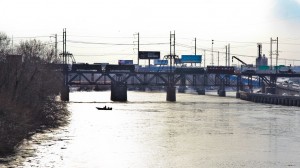Tank cars moving crude by rail through Pa. need a makeover
A series of high-profile derailments hasn’t stopped the flow of trains hauling crude oil through Pennsylvania to refineries along the Delaware River.
This week, PublicSource takes a look at the tank cars, known as DOT-111s, that are holding all this oil. They’re the same cars that were involved in a 2006 derailment in New Brighton, Pa.
More from PublicSource:
No one was injured, but 150 people were evacuated and a multi-million dollar cleanup ensued in the city about 30 miles Northwest of Pittsburgh.
The rail cars in the accident were DOT-111s, designed in the early 1960s and originally used to haul non-hazardous materials such as corn syrup. Now, they are the worker bees for the glut of crude oil and ethanol being transported across Pennsylvania and the country.
“The same old clunkers are still out there,” said Fred Millar, a Washington, D.C., consultant to the rail industry. “They’re pepsi cans on wheels.”
The railroads recently agreed to voluntary changes to make shipping oil by rail safer in the short-term and the federal government is now requiring shippers to test each load of crude. However, concerns linger about the safety of these tank cars that continue to bring hundreds of thousands of barrels of oil each day to Philadelphia alone.
PublicSource reports it may take at least a year before federal regulations for new cars are approved and the old tankers are phased out:
The job of writing the regulations falls to the U.S. Department of Transportation’s Pipeline and Hazardous Materials Safety Administration (PHMSA).
In September, PHMSA put out a notice asking for comments from citizens, environmental and industry groups, and railroad companies on proposed rules to improve the design of the DOT-111 tank car, as well as other safety rules.
PHMSA officials said they’ve been busy since the comment period ended in December analyzing numerous comments on the rules. But changes aren’t pegged to come until early 2015, according to the agency’s timeline.
This month, a Senate panel grilled regulators on taking too long to pass regulations improving the tank cars used to haul crude.
The panel’s chairman, Sen. Richard Blumenthal, D-Conn., said he was “disappointed and disturbed by some of the delays and failures in rulemaking and scrutiny.”
PHMSA head Cynthia L. Quarterman told the panel that her agency is working as fast as possible.
A PHMSA spokesman, Joe Delcambre, told PublicSource in an email that “it was crucial to get input from a wide variety of stakeholders, including shippers and carriers, state and local officials and concerned citizens.”
The AAR estimates there are 92,000 DOT-111 tank cars used to transport hazardous chemicals and that more than 75,000 of those would need to be retrofitted or possibly to be phased out. These tank cars are not usually owned by railroads but by chemical or oil producers and leasing agencies.
StateImpact Pennsylvania’s Marie Cusick recently took a video of one of these oil trains near Philadelphia’s 30th Street Station:

















